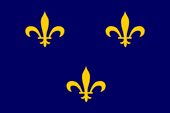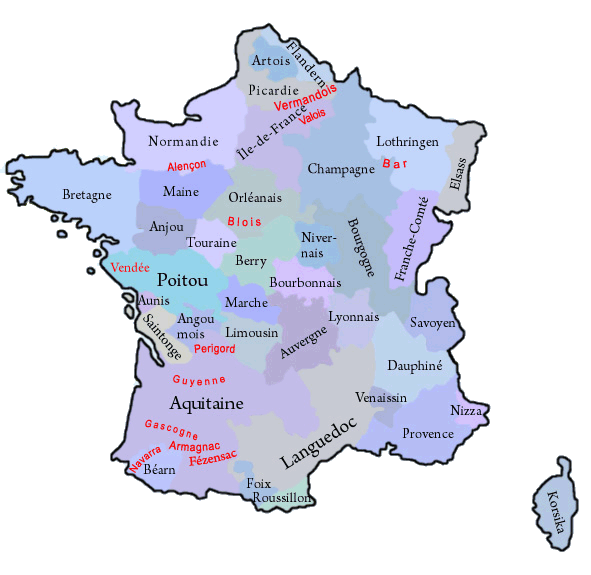mobile View, to the German Version tap the flag


- historical region in today's France
- former province
- former name: Francia
• Flag
• Meaning/Origin of the Flag
• Coat of Arms
• Meaning/Origin of the Coat of Arms
• Map of the historical Regions in France
• Explanations about the Regions
• History
• Origin of the Country's Name

Flag of the Île-de-France
– drapeau de l' Île-de-France,
Source, by: Die Welt der Flaggen






The historic flag of Île-de-France was a scutcheon-flag. It showed the image of the historic coat of arms. The in 1960 created Region of "Île-de-France" uses an ununofficial flag modeled after the historical coat of arms of Île-de-France. It shows actually the image of the coat of arms of the Kings of France from the House of Capet (Capetians, Kings of France 987-1328). The Île-de-France was their ancestral homeland and the most important part of the crown domain.
Source:
Volker Preuß,
Wikipedia (D)


Coat of arms of the Île-de-France,
Source, by:
Wikipedia (D)

The coat of arms of the Île-de-France is the coat of arms of the Kings of France from the House of Capet (Capetians, Kings of France from 987 to 1328). The coat of arms of the Capetians showed three golden lilies on blue, but originally was the coat of arms sprinkled with lilies. From 1365 (by others sources 1376), the number of lilies was reduced to three. The lily-symbol is very old, already the Germanic tribe of the Franks has used it. The House of the Capetians has provided the kings of France between 987 and 1328. It goes back to Hugo Capet, son of Hugo the Great, who was electet to the King of France, in 987, after the death of King Ludwig V. from the House of the Carolingians. The Capetians brought out three branch lines which became the Kings of France: Valois 1328–1589, Bourbon 1589–1792 and 1814–1830, and Orléans 1830–1848.
Source:
Lexikon der Heraldik,
Wikipedia (D),
Volker Preuß

The historical, French Regions:

in black: governorate and province in 1776,
in red: former county, province oder governorate
Map: Volker Preuß

The until the French Revolution existing provinces (or governorates) have been historically grown structures, which had their roots oftenly in former fiefdoms of the French crown, historic counties and duchies. They oftenly existed for hundreds of years and had preserved regionality (e.g. cultural particularities and regional languages). On the occasion of the French Revolution such phenomena were of course not desirable, and as part of their bloody and violent egalitarianism any regional references were eliminated. Shortly after the French Revolution the provinces were dissolved and France became divided into many départements, which should have approximately the same size and the same status. The départements were named after rivers or mountains, to use never and in no circumstances the name of an old province. However, there was no success in cutting the connections of the people of France to their respective regions, so that administrative regions were re-created in 1960, to have a better control in regional administrative processes. In this way became départements, which were placed in a historical province, administratively grouped to an oftenly historically named region. The resulted structures coincide only approximately with the boundaries of the old provinces. In the strictly centralist France any regionality is avoided, so that even the official flags of these regions mostly look like flags of companies, unloving, unhistorical, technocratic and modernistic, and these flags should not be a subject of any lexical considerations here. Only in a few of that regions, exist official flags which remember the historical models. But, even the existence of these today's regions is douptful, because in 2014 was passed a territorial reform valid from the year 2016, that reduces the number of the existing regions by merging to nearly the half. However, there exist unofficial flags in nearly all of these regions, which should remember the old provinces and the old heraldry.
Wikipedia Link to the regions of France:
click or tap here
FOTW Link to the regions of France:
click or tap here
Source: Flags of the World,
Wikipedia (D),
Volker Preuß

9th century · probable foundation of the County of Paris
865 · the first Duke of "Francia", called Robert the Strong, fends off the Normans on the Loire River
866 · Robert the Strong fends off again a Norman attack
880 · at the division of the Frankish Empire (Treaty of Verdun and Ribbemont) was created the West Frankish Kingdom (the later France) under a line of the Carolingians
898 · death of Robert the Strong, succession by his brother Robert II.
922 · Robert II. calles himself King of France
923 · Robert II. dies in the Battle of Soissons, the inheritance goes to his son Hugo the Great, he wins the battle, but rejects the crown of France
936 · Hugo the Great is guardian of King Louis IV.
942 · Hugo the Great receives Neustria (now Northern France) and Burgundy
956 · death of Hugo the Great
987 · death of Louis V. (986–987) from the house of the Carolingians, Hugo Capet, son of Hugo the Great was elected to the King of France and becomes the founder of the Capetian dynasty (Kings of France 987–1328), the Counties of Paris, Orléans, Melun and Etampes become the ancestral homeland of the kings of France (called also Francia or Île de France), whose power base and crown domain, the later gouvernorate (province) of Île de France with approximately 8.500 sq.mi.
1776 · the already in the 14th century created governorates of the civil administration of the kingdom of France become committed to a number of 39, and correspond in this way to the number of provinces, in previous years could any provinces be summarized in one governorate
1789 · French Revolution, the governorates (provinces) become abolished, the Île de France is divided into departments
1960 · reintroduction of regions in France, formation of the Region of Île de France, however, but not within the historic boundaries, just by integrating the departments of Paris, Seine-et-Marne, Yvelines, Essonne, Hauts-de-Seine, Seine-Saint-Denis, Val-de-Marne, Val-d'Oise
Source:
Wikipedia (D),
Meyers Konversationslexikon

The name Île-de-France ("Island of France") refers to the local situation of this region between the Seine, Marne, Oise and Beuvronne rivers. Probably the name goes back to the antiquated term "Liddle Franke," meaning "Little Franconia" or "Little France". In the old times the name "Francia" for this region was widespread, but it is outdated.
Source:
Wikipedia (D),
Meyers Konversationslexikon


![]()







